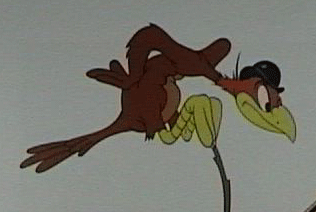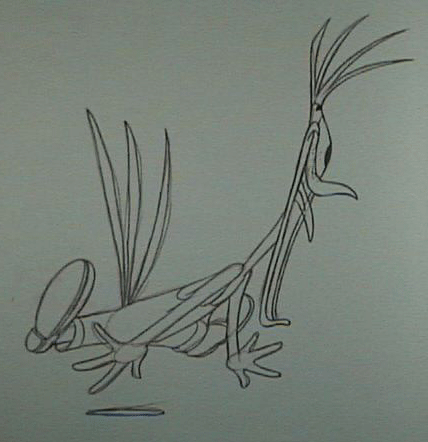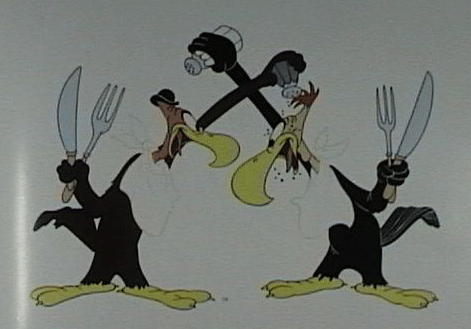Getting Back To Cartoony Cartoons Part 3
This is the third in a multi-part series on the subject of cartoons and cartoon making. My goal in these articles is to explore writing and making the short format cartoon which can range in length from 1 to 7 minutes. If you missed the first two parts of this series you can read them here Part 1 and here Part 2.
Tex Avery is perhaps one of the most influential of all cartoon directors. His style is very distinctive and it significantly advanced the making of cartoons and reflected an irreverence that has carried forth for generations of cartoon makers. Tex wanted his stuff to be as different from Disney as jazz is from classical music. Disney’s goal was to create “the illusion of life” while Avery wanted to celebrate cartoons as cartoons. He wanted to accentuate the unique nature of drawn animation not camouflage it.
If you aren't familiar with Tex Avery you really need to take the time to become acquainted with his cartoons, particularly the ones he did at MGM. When watching a Tex Avery cartoon it is hard not notice that he was wildly absurd, sometimes bordering on stream of consciousness, things jump about like rampant attention deficency run amuck. Tex's work is well known for his use of strong poses and extreme exaggeration. It is high energy, very elastic movement, with lots of literally "eye popping" action. If you don't know what squash and stretch mean, just watch a Tex Avery cartoon and you will see it taken to the limits. He practiced extreme animation. And nobody ever put more beautiful, curvaceous women in their cartoons than Tex.
Disney was focused on personality and characterization but Avery felt what happened to a character was more important than who they were. His characters aren't the memorable icons of Warner Brother's Looney Tunes although Tex is often referred to as the father of Bugs Bunny and Daffy Duck. But in most of Tex's cartoons you don't remember the characters as much as you remember the action and the gags. He used very stylized character designs that were more suggestive of the stereotypes that his characters represented rather than detailed personality characterizations. Wolves represented just that, the stereotype woman crazy image of a wolf, very 1940's. And Tex didn't just use cars, his cars are sleek and two miles long, the essence of "male potency" more explicit than any Detroit auto commercial.
Tex Avery's cartoons were full of highly visual gags most often not needing any dialogue. He often breaks with theatrical tradition and has his characters interacting directly with the audience or stopping their performance and making fun of the fact that this is a cartoon not reality. Things like in the middle of a chase sequence the color goes away and everything becomes "black and white" because the characters just ran past a sign that says “Technicolor Stops Here". Or a minute into a cartoon the characters stop and begin discussing the fact that they don't fit the title of the cartoon so they literally walk on to the opening title sequence and look at the words and decide "yep, we are totally in the wrong cartoon."

One of my favorite Tex Avery gags, has a character stop and reach out and remove a loose hair that appears to have gotten caught in the projector that is showing the cartoon. Or Tex has a character stop and hit the silhouette of a movie theater patron in the head with a mallet when he starts to leave his seat in the middle of the cartoon. Tex seemed to love to make fun of the whole movie mystique.
To watch a Tex Avery cartoon is to expect the unexpected because Tex loved to go anywhere to get to a gag. He was a master of setting up gags and milking them for all they were worth. And Tex's gags weren't just simple quick things; he more often built up chain reactions of gags with ever increasing visual escalations. First he hits the character with a falling flower pot, and then a falling safe or an anvil, and so on until he has dropped everything on the poor guy except the kitchen sink, so then he drops the sink followed by a bath tub, a car and an ocean liner. Disney may have brought personality to cartoons but Tex Avery brought the insanity.
In person Tex Avery was a very shy and unassuming artist, but behind the camera he was lightning in a bottle. Before Tex Avery, cartoons were fairly slow paced but the longer Tex Avery was in the business the faster he pushed the pace of his work and everyone elses. He could and would squeeze more action and gags into 6 minutes than anyone before or since. Perhaps it was his personal insecurity, but Tex wanted to make sure his audience got their moneys worth.
 We all owe a great deal to Tex Avery for his contribution to the art of cartoon making. He taught us how to celebrate the unique nature of the art of animation. He made us laugh and appreciate that in his world nothing was impossible if it could be drawn. -End of Part 3-
We all owe a great deal to Tex Avery for his contribution to the art of cartoon making. He taught us how to celebrate the unique nature of the art of animation. He made us laugh and appreciate that in his world nothing was impossible if it could be drawn. -End of Part 3-
Tex Avery is perhaps one of the most influential of all cartoon directors. His style is very distinctive and it significantly advanced the making of cartoons and reflected an irreverence that has carried forth for generations of cartoon makers. Tex wanted his stuff to be as different from Disney as jazz is from classical music. Disney’s goal was to create “the illusion of life” while Avery wanted to celebrate cartoons as cartoons. He wanted to accentuate the unique nature of drawn animation not camouflage it.
If you aren't familiar with Tex Avery you really need to take the time to become acquainted with his cartoons, particularly the ones he did at MGM. When watching a Tex Avery cartoon it is hard not notice that he was wildly absurd, sometimes bordering on stream of consciousness, things jump about like rampant attention deficency run amuck. Tex's work is well known for his use of strong poses and extreme exaggeration. It is high energy, very elastic movement, with lots of literally "eye popping" action. If you don't know what squash and stretch mean, just watch a Tex Avery cartoon and you will see it taken to the limits. He practiced extreme animation. And nobody ever put more beautiful, curvaceous women in their cartoons than Tex.

Disney was focused on personality and characterization but Avery felt what happened to a character was more important than who they were. His characters aren't the memorable icons of Warner Brother's Looney Tunes although Tex is often referred to as the father of Bugs Bunny and Daffy Duck. But in most of Tex's cartoons you don't remember the characters as much as you remember the action and the gags. He used very stylized character designs that were more suggestive of the stereotypes that his characters represented rather than detailed personality characterizations. Wolves represented just that, the stereotype woman crazy image of a wolf, very 1940's. And Tex didn't just use cars, his cars are sleek and two miles long, the essence of "male potency" more explicit than any Detroit auto commercial.
Tex Avery's cartoons were full of highly visual gags most often not needing any dialogue. He often breaks with theatrical tradition and has his characters interacting directly with the audience or stopping their performance and making fun of the fact that this is a cartoon not reality. Things like in the middle of a chase sequence the color goes away and everything becomes "black and white" because the characters just ran past a sign that says “Technicolor Stops Here". Or a minute into a cartoon the characters stop and begin discussing the fact that they don't fit the title of the cartoon so they literally walk on to the opening title sequence and look at the words and decide "yep, we are totally in the wrong cartoon."

One of my favorite Tex Avery gags, has a character stop and reach out and remove a loose hair that appears to have gotten caught in the projector that is showing the cartoon. Or Tex has a character stop and hit the silhouette of a movie theater patron in the head with a mallet when he starts to leave his seat in the middle of the cartoon. Tex seemed to love to make fun of the whole movie mystique.
To watch a Tex Avery cartoon is to expect the unexpected because Tex loved to go anywhere to get to a gag. He was a master of setting up gags and milking them for all they were worth. And Tex's gags weren't just simple quick things; he more often built up chain reactions of gags with ever increasing visual escalations. First he hits the character with a falling flower pot, and then a falling safe or an anvil, and so on until he has dropped everything on the poor guy except the kitchen sink, so then he drops the sink followed by a bath tub, a car and an ocean liner. Disney may have brought personality to cartoons but Tex Avery brought the insanity.
In person Tex Avery was a very shy and unassuming artist, but behind the camera he was lightning in a bottle. Before Tex Avery, cartoons were fairly slow paced but the longer Tex Avery was in the business the faster he pushed the pace of his work and everyone elses. He could and would squeeze more action and gags into 6 minutes than anyone before or since. Perhaps it was his personal insecurity, but Tex wanted to make sure his audience got their moneys worth.
 We all owe a great deal to Tex Avery for his contribution to the art of cartoon making. He taught us how to celebrate the unique nature of the art of animation. He made us laugh and appreciate that in his world nothing was impossible if it could be drawn. -End of Part 3-
We all owe a great deal to Tex Avery for his contribution to the art of cartoon making. He taught us how to celebrate the unique nature of the art of animation. He made us laugh and appreciate that in his world nothing was impossible if it could be drawn. -End of Part 3-
0 Comments:
Post a Comment
<< Home